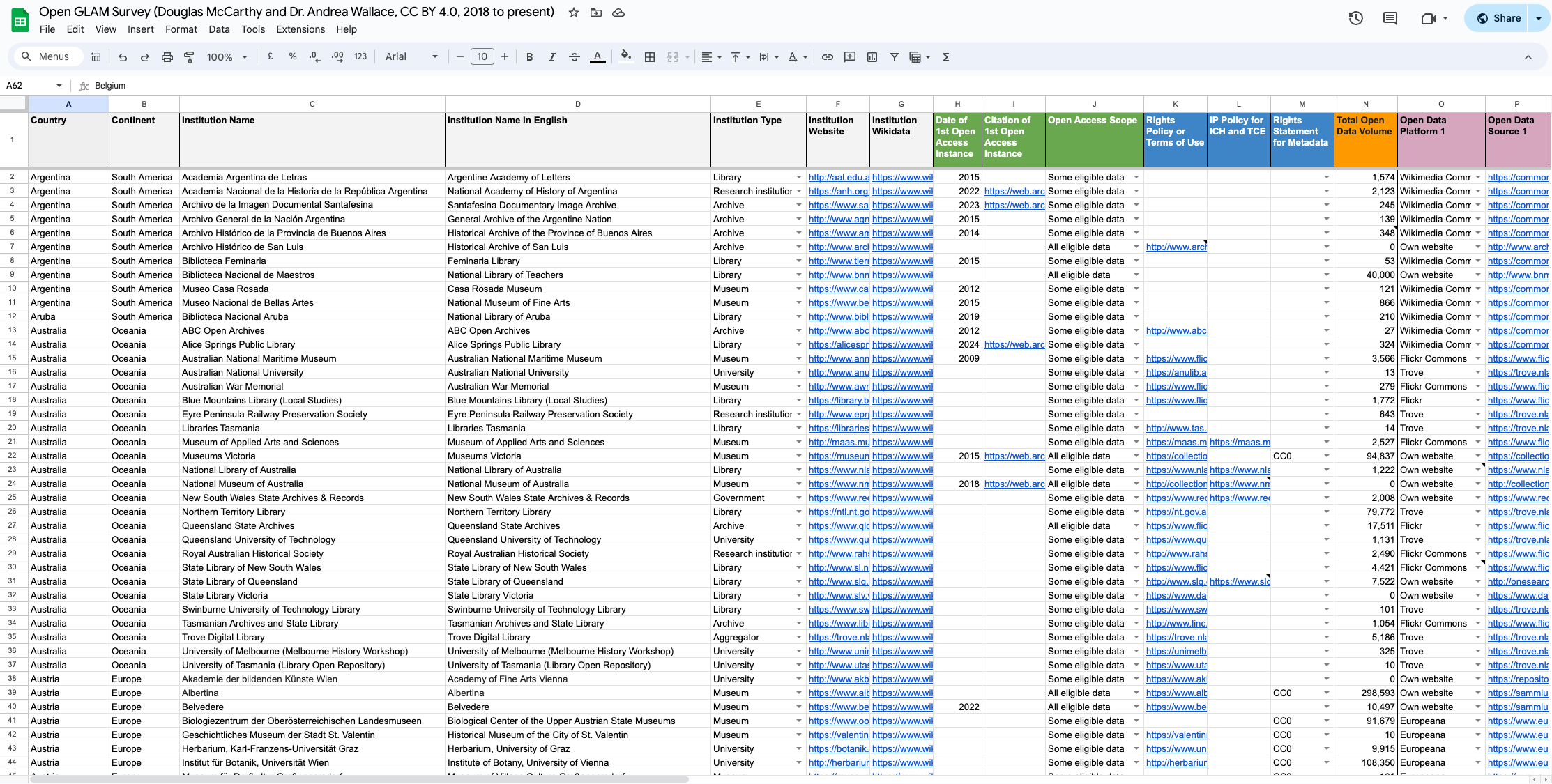Help us protect the commons. Make a tax deductible gift to fund our work. Donate today!

Creative Commons’ Open Culture Platform is supporting 25 institutions in opening up access to their collections by the end of 2025. Members of the Platform community will be working together to create a policy template, conduct outreach, identify risk management strategies, and provide a guide for identifying which collections’ items to openly license first. Initiatives like Douglas McCarthy and Andrea Wallace’s Open GLAM Survey and the GLAM-E Lab provide essential resources to the GLAM community who are working collaboratively top open access to our cultural heritage. Read on to learn more about the Open GLAM Survey and its contributions to open culture.
The Open GLAM Survey
Back in 2018, there was a lack of comprehensive, up-to-date information about open GLAM policy and practice at national or international levels – and no shared place for the growing open GLAM community to see or add relevant data. Motivated to better understand and share that global picture, Douglas and Andrea created the Survey and began collecting instances of digitised public domain collections released by GLAMs for any reuse purpose. From an initial list of around 40 organisations, the Open GLAM Survey was born, housed in a publicly accessible Google Sheet where it remains to this day.

Today, the Survey includes over 1687 cultural institutions and organisations from 55 countries, focusing on open collections made available on their websites or external platforms. It offers direct links to almost 100 million public domain and openly licensed digital surrogates. Over the years, the Survey has expanded in scope and complexity, documenting a range of data points, including institution type, geographical location, rights statements, APIs, terms of use, open data volume, and many more. It is also comprehensively recorded in Wikidata.
In addition to an ‘About This Survey’ tab, users will find tabs containing informative visualisations on various aspects of the data, such as the one below.

Given the diversity of practice among GLAMs claiming new copyrights in digital surrogates of public domain works, Douglas and Andrea review all entries to ensure their policies meet the international standards of ‘open’. The Survey is guided by Open Knowledge Foundation’s Open Definition and its statement that ‘open means anyone can freely access, use, modify, and share [content] for any purpose’. The Open Definition provides a list of licenses, rights statements, and legal tools that accord with this statement and the Survey’s authors have augmented the list with other statements (such as The Commons on Flickr’s ‘no known copyright restrictions’).
The Survey’s granular recording of the open licenses, public domain tools, and equivalent rights statements that GLAMs apply to digital surrogates and metadata means that it contains a treasure trove of information for a range of users, including:
- students of copyright law, the digital humanities, art and cultural heritage, and museum studies
- practitioners looking to design their own open access policy, using examples from the international landscape, or nationally if there are jurisdiction-specific issues at play
- policymakers who want to find examples of good practice to reference
- anyone who wants to reuse cultural heritage and digital collections without having to pay image fees
From the start, the Survey has been developed by, with, and for members of the Open GLAM community. In addition to the desk-based research that forms its foundation, the Survey has gained much from the contributions of open culture enthusiasts, heritage professionals, and Wikipedians. The Survey has been presented to international audiences by Douglas and Andrea, cited in numerous academic articles and, in 2018, was referenced in a UK Parliament debate on how museums and galleries balance public access with commercial reuse of digital content.
Using GLAM websites, data aggregators, third party platforms, and information circulated among the wider open GLAM community, the Survey tracks open access activity at all scales, ranging from a historical centre’s single CC0 image published to Wikimedia Commons, to a national archive’s publication of millions of images on Europeana. The Survey is constantly growing as new GLAMs are identified and verified as meeting the criteria for inclusion. This means that the Survey includes all known examples of open GLAM policy and practice; however, it is by no means exhaustive. Indeed, there are clear representation gaps in the data – which in themselves are important to document and highlight, as shown by the map below.

In this way, the Survey will likely never be complete – Andrea and Douglas are confident that there are undiscovered instances of open practice awaiting inclusion, alongside numerous new open GLAM participants expected to emerge in the years ahead.
Do you know a cultural institution or organisation that’s missing from the Survey? Are there other data points that would be useful to collect for the open GLAM community? Have you used the Survey data in some way? Are you a CC Open Culture Platform member that has helped an institution move to open? If so, Douglas and Andrea would be delighted to hear from you. You can propose a new entry using this Google Form or contact Andrea and Douglas via email at openglamsurvey@gmail.com.
To find out more about the Open GLAM Survey:
- Watch Andrea and Douglas present on open GLAM at this Australian Digital Alliance webinar
- Take a look at this series of articles by Douglas
- Read this op-ed by Douglas and Andrea for the international art magazine Apollo
- See how the Survey data has been used Andrea’s recent paper on the open GLAM landscape
- Check out the Open GLAM Survey
- Check out the free resources and other work by the GLAM-E Lab
Would you like to get involved in CC’s efforts to move more institutions toward open? Join the Open Culture Platform, where you can learn more about each working groups’ efforts and how you can help move 25 institutions by 2025.
Posted 26 June 2024